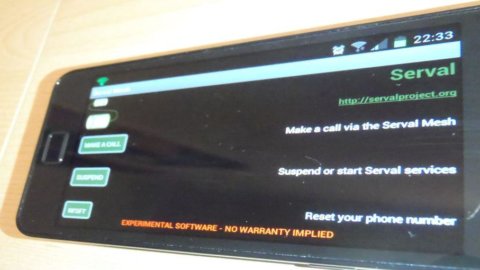Le mesh networks they talk about themselves again, again as a key tool for the creation of innovative technologies from the bottom up. The idea came to a researcher at Flinders University in Adelaide, Australia and consists of making two smartphones relatively distant from each other talk to each other, without the need for cellular antennas, ergo without the need for a mobile operator.
The project, which is called "Serval” (African leopard), has been successful and has already distinguished itself in further humanitarian applications: for example, allowing communication in disaster areas of the planet, where the antennas have been destroyed or have never been there. On the other hand, to financially support the Dr. Paul Gardner-Stephen, this is the name of the researcher, there is the Shuttleworth foundation of the open-source champion Mark Shuttleworth, already engaged in similar philanthropic activities and father, through Canonical Ltd, of Ubuntu, the most popular Linux distribution in the world.
How does it work? First of all you need to get a smartphone based on Android (no iPhone, no Windows Mobile). On the marketplace you can find the only free application called “Serval”, you download and install it. At this point it must be remembered that the project is in development phase e there are no guarantees about any side effects while using the software. The description page of the app is understandably full of warnings and contraindications but that's not all because, after this screen too, you need to pass the system requirements test, namely: enabling "root" rights on the device, enabling installation from sources unknown, software controllable WiFi chipset. Serval is based on several open-source protocols, such as the "SIP” used in VoIP applications, the BATMAN (Better Approach To Mobile Adhoc Networking) or theOSLR (routing protocol also adopted by Ninux, one of the largest Italian wireless mesh networks). Once the other possible choices have been configured, a call can be started simply by dialing a similarly equipped mobile number (also from the address book).
In this first version, Serval uses the Wi-Fi transmitters of phones, but the next one will be based on GSM frequencies, which – at least in Europe – may conflict with national legislation. Another speech must be made for i developing countries, in marginal areas neglected by telephone operators because they are not very profitable, and in areas affected by natural disasters, where there are blackouts in the telecommunications networks.
It is clear that Serval could be very annoying to mobile telecommunications operators who already have to deal with Voice over IP and with the thousands of instant messaging applications between smartphones (whatsapp, skype, viber just to name a few). In the 1980 – recalls Gardner-Stephen – the engineers who worked on the first prototypes of GSM networks had already imagined the mesh topology with devices that were both receivers and signal repeaters, but the telephone companies had prevented them from working in this direction because they wanted to keep the pyramid model controlled from above. Model inherited from the corded telephone, technically obsolete, but very profitable.
Even today, from a technical point of view, the cell phone could be used as an open, multi-directional walkie-talkie, since most devices are inherently equipped with the necessary technology for "ad hoc" connections. In the 2004 was also launched by the manufacturer Nokia a type system PTT (Push To Talk) which was meant to be a way to connect two mobile terminals directly, but in the end the service was provided by the telephone operators in such a way that the signal was directed towards the fixed transmitters. Only in this way could they control and invoice the conversations.
Even before the Serval project, some researchers from the automation and computer science department of the Polytechnic of Turin had worked hard to find a valid alternative to infrastructural wireless networks, at the time also driven by the need to overcome the digital divide. In 2007, the solution was found thanks to mesh networks where each device automatically became an active part of the network collaborating in its extension, stabilization and optimization in the use of the band. The success of the criterion of distributing the intelligence of the routers over the entire network, therefore independent of the presence of concentrators, is beyond question, so much so that a network of this type was chosen for the Wi-Fi coverage of the very modern stadium of the Juventus Football Club and was created by the start-up born within theInnovative Business Incubator of the Turin Polytechnic (I3P).
At this point the question arises: why are the researchers led by Garner-Stephen, instead of making it a business, are conducting their research offering the fruits to anyone? The answer is at the bottom of the home page of the project site and reports the words of Gardner-Stephen himself: “We believe that access to communications and information is a human right. We dream of a world where everyone is connected anytime, anywhere".





